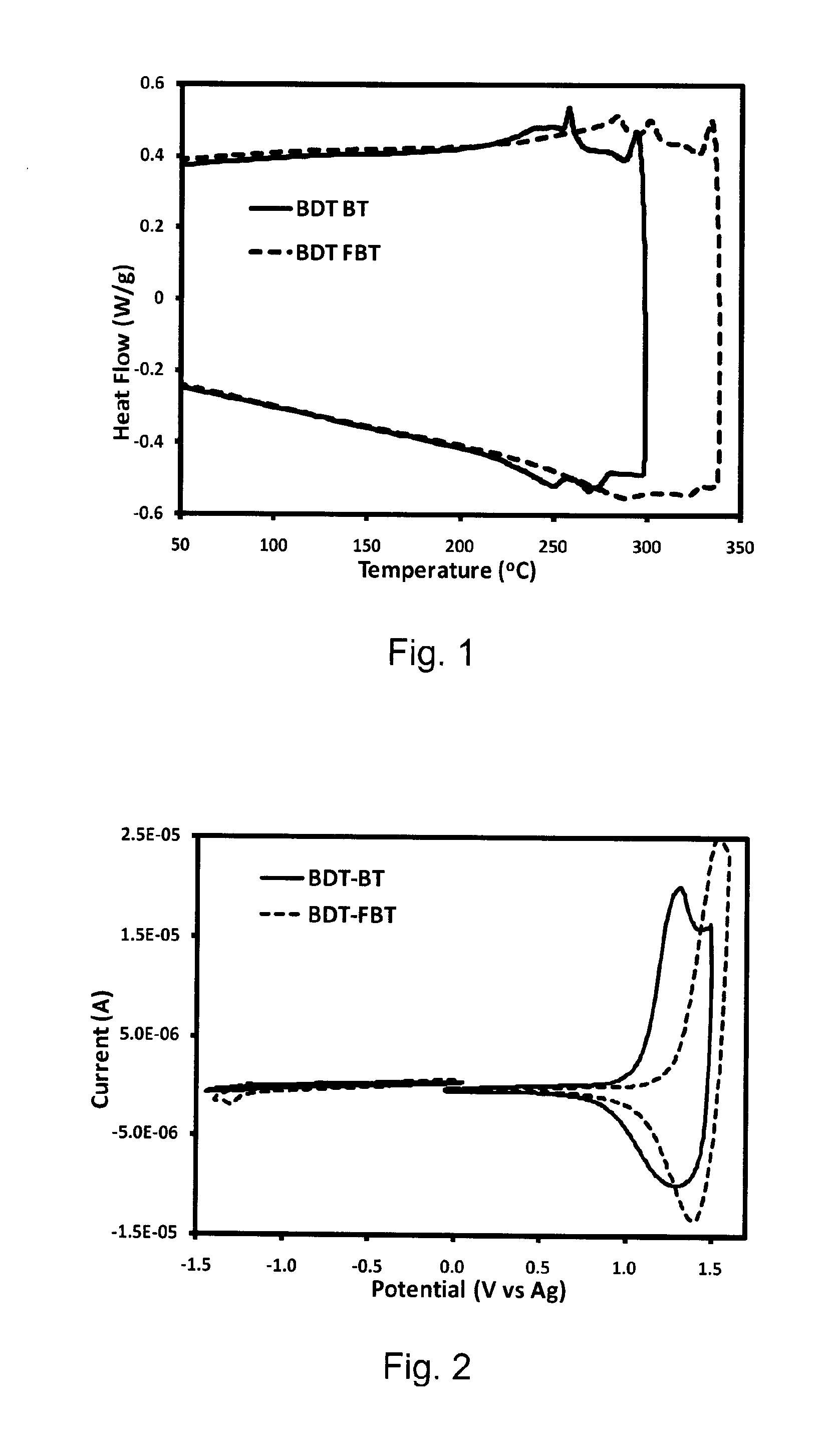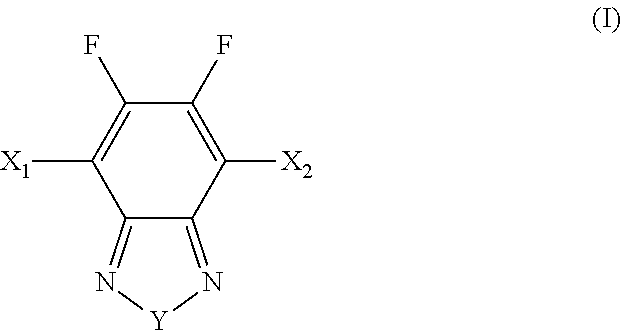Fluorinated Monomers, Oligomers and Polymers for Use in Organic Electronic Devices
a technology of organic electronic devices and fluorinated monomers, which is applied in the field of fluorinated monomers, oligomers and polymers for use in organic electronic devices, can solve the problems of limited number of methods to successfully introduce fluorine, limited number of fluorinated monomers with strong electron withdrawing ability, and difficulty in carrying, so as to reduce the homo and lumo energy levels of oligomers and polymers, and improve the effect of mobility and mobility
- Summary
- Abstract
- Description
- Claims
- Application Information
AI Technical Summary
Benefits of technology
Problems solved by technology
Method used
Image
Examples
example 1
Synthesis of Fluorinated Monomer (Monomer 2)
Step 1
Synthesis of 2,3-difluoro-1,4-dibromo-5,6-dinitro-benzene
[0031]2,3-difluoro-1,4-dibromo-benzene as the starting raw material was synthesized according to prior methods (Dunn 2006). In a 250 ml flask, concentrated sulphuric acid (50 ml) was added and cooled to 0-5° C. in an ice water bath. Fuming nitric acid (50 ml) and 2,3-difluoro-1,4-dibromo-benzene (10 g, 36.8 mmol) were slowly added. Then, the flask was heated to 65° C. for 14 h. The mixture was then precipitated into ice water. The resulting yellow solid was filtered and purified by column chromatograph with a mixture of hexane and dichloromethane (1:4 v / v) to afford 2,3-difluoro-1,4-dibromo-5,6-dinitro-benzene (3.5 g, 26%). 1H and 19F NMR spectra were as expected.
Step 2
Synthesis of 2,3-difluoro-1,4-di(2-thienyl)-5,6-dinitro-benzene
[0032]2,3-difluoro-1,4-dibromo-5,6-dinitro-benzene (3.62 g, 10.0 mmol), 2-tributyl stannyl-thiophene (8.21 g, 22.0 mmol) and dichlorobis(triphenylp...
example 2
Synthesis of Other Monomers
[0036]In a manner similar to the synthesis of Monomer 2 in Example 1, four other monomers were synthesized. Table 1 lists five examples of monomers that were synthesized in this manner.
TABLE 1CompoundStructureMonomer 1Monomer 2Monomer 3Monomer 4Monomer 5
example 3
Synthesis of Fluorinated Conjugated Polymer BDT-FBT from Monomer 3
[0037]Carefully purified 2,6-bis(trimethyltin)-4,8-bis(3-pentyl undecyl)benzo[1,2-b:4,5-b′]dithiophene (0.289 g, 0.300 mmol), 5,6-difluoro-4,7-bis(5′-bromo-3,4′-dioctyl-2,2′bithiophen-5-yl)-2,1,3-benzothiadiazole (0.205 g, 0.300 mmol) were added in a small flask and purged with Ar several times. Then (PPh3)4Pd(0) (1 mol %) was added in a dry box. Toluene (8 ml) was added. The mixture was stirred and refluxed for 24 h before being poured into methanol. The resulting fibre-like polymer (BDT-FBT) was filtered and washed with hexane and acetone to afford a red solid (0.20 g, 57%). 1H and 19F NMR spectra were as expected. A non-fluorinated polymer (BDT-BT) was synthesized in a similar manner except that a non-fluorinated monomer was used (Lu 2008). The structures of BDT-FBT and BDT-BT are shown in Scheme 4.
PUM
| Property | Measurement | Unit |
|---|---|---|
| Ratio | aaaaa | aaaaa |
Abstract
Description
Claims
Application Information
 Login to View More
Login to View More - R&D
- Intellectual Property
- Life Sciences
- Materials
- Tech Scout
- Unparalleled Data Quality
- Higher Quality Content
- 60% Fewer Hallucinations
Browse by: Latest US Patents, China's latest patents, Technical Efficacy Thesaurus, Application Domain, Technology Topic, Popular Technical Reports.
© 2025 PatSnap. All rights reserved.Legal|Privacy policy|Modern Slavery Act Transparency Statement|Sitemap|About US| Contact US: help@patsnap.com



